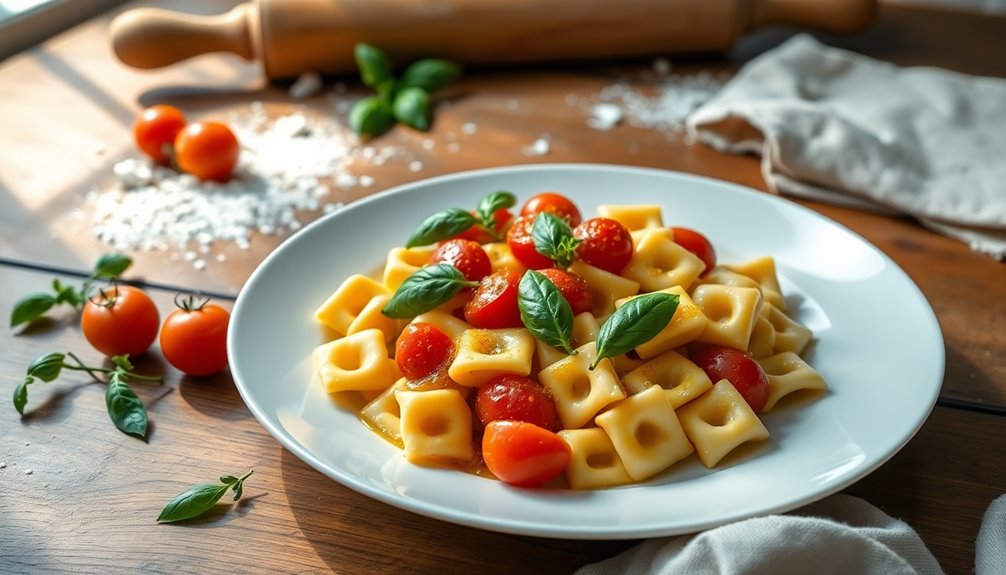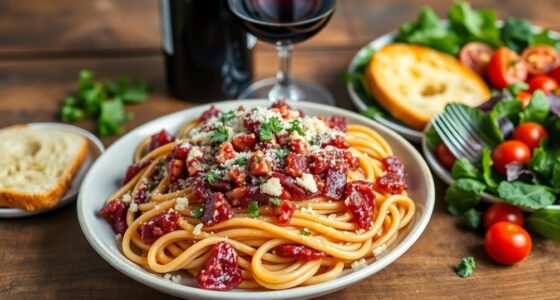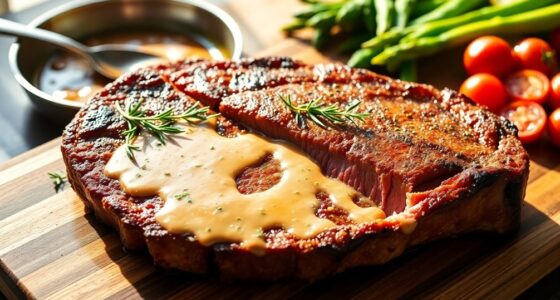Homemade cavatelli is a delicious eggless pasta that's easy to make. With just semolina flour, water, and a pinch of salt, you can create this chewy delight. Knead the dough until smooth, shape it into small pieces, and cook them in boiling salted water for 8-10 minutes. Toss the cavatelli with your favorite sauce for a satisfying dish. If you're curious about the history and tips for perfecting your pasta, there's more to explore!
History
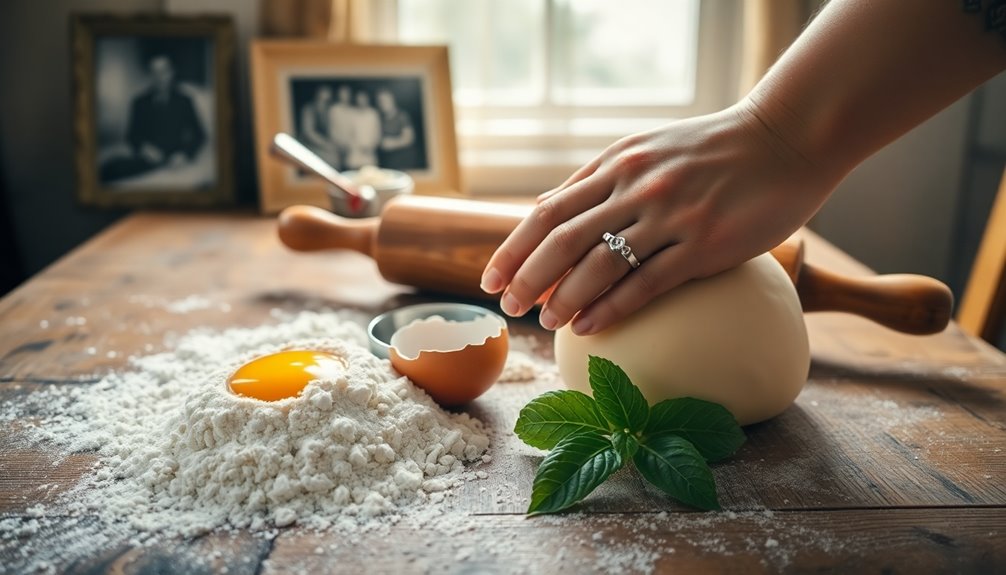
Cavatelli, originating in Southern Italy, has a rich history that reflects the resourcefulness of its creators.
Particularly popular in Puglia, this eggless pasta arose from the need for simple, affordable ingredients like semolina flour and water. The name "cavatelli" comes from the Italian word "cavare," which means "to scoop out," describing the pasta's unique shape achieved by pressing and rolling the dough.
For centuries, cavatelli has been a staple in Italian cuisine, often paired with rich sauces that cling beautifully to its distinctive texture.
As you explore its history, you'll see how this humble dish has gained worldwide popularity, celebrated for its delightful chewiness and versatility in homemade meals.
Recipe
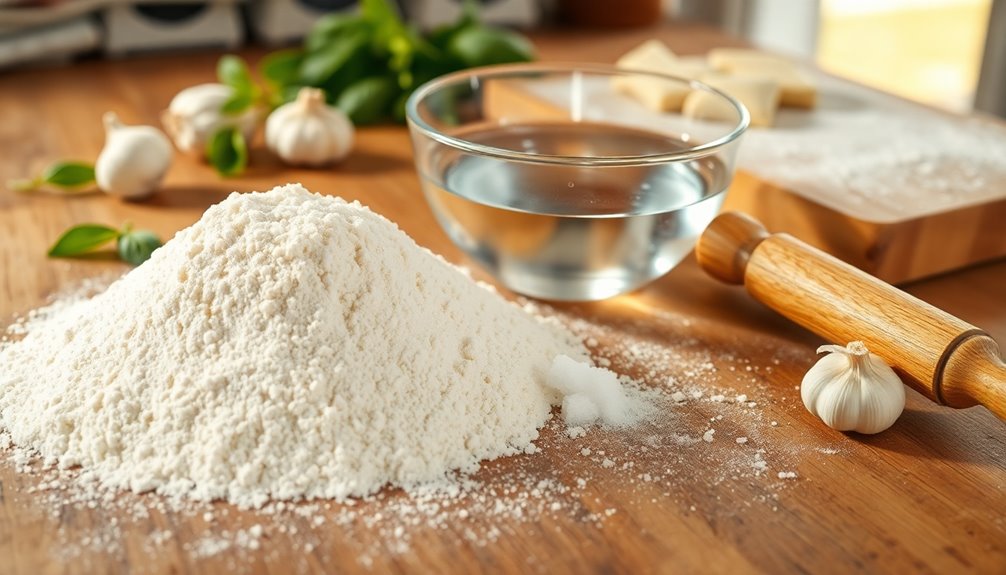
Ingredients:
- 400 g fine semolina flour
- 250 mL water
- Pinch of salt
To make the cavatelli, combine the fine semolina flour, water, and a pinch of salt in a mixing bowl. Knead the mixture until it becomes smooth and elastic, which should take about 10 minutes.
Once your dough is ready, cover it with a damp cloth and let it rest for 30 minutes.
After resting, roll the dough into long ropes, approximately ½ inch in diameter, and cut them into ¾-1 inch pieces. Shape each piece by pressing it with your thumb and rolling it on a gnocchi board or a fork to create the classic indentation.
To cook, bring a large pot of salted water to a boil and add the shaped cavatelli. Cook for 8-10 minutes, checking for doneness after 5 minutes; they're done when they float to the surface.
Extra Tips:
When making cavatelli, verify that your dough isn't too sticky; if it is, you can sprinkle a bit more semolina flour while kneading.
For the best texture, avoid overcooking the cavatelli; they should be al dente.
If you wish to prepare cavatelli in advance, refrigerate uncooked pieces for up to 3-4 days or freeze them for up to 6 months after arranging them in a single layer on a baking sheet.
Finally, don't hesitate to experiment with different sauces — cavatelli pairs wonderfully with everything from simple olive oil and garlic to rich meat-based sauces. Enjoy your homemade creation!
Cooking Steps
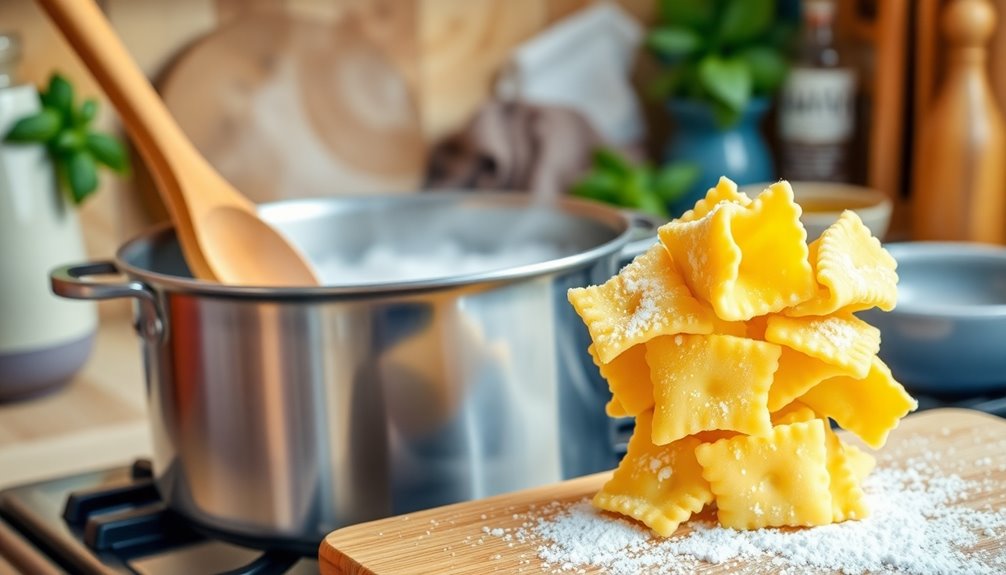
Now that you've got your dough ready, it's time to transform it into delicious cavatelli.
You'll need to knead, roll, and shape the dough before cooking it to perfection.
Let's walk through the essential steps to get your homemade pasta on the table!
Step 1. Knead Dough Until Smooth
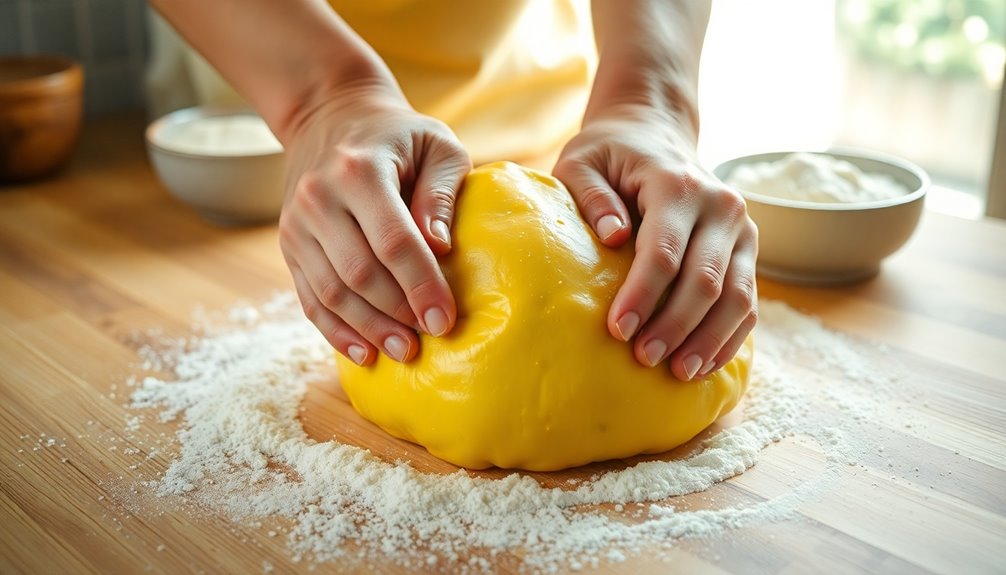
Begin kneading the cavatelli dough for 10 to 15 minutes until it's smooth and elastic. As you knead the dough, it should resemble soft playdough.
If it feels too sticky, lightly dust it with semolina flour. Properly kneading hydrates the flour and develops gluten, which is essential for that chewy texture in your final pasta.
Keep an eye on the consistency; the ideal dough shouldn't be too wet or dry. You might need to adjust the water based on the flour's absorbency.
Once you've achieved a smooth and elastic dough, allow it to rest for at least 30 minutes. This rest period relaxes the gluten, making it easier for you when rolling the dough later on.
Step 2. Roll Into Small Pieces
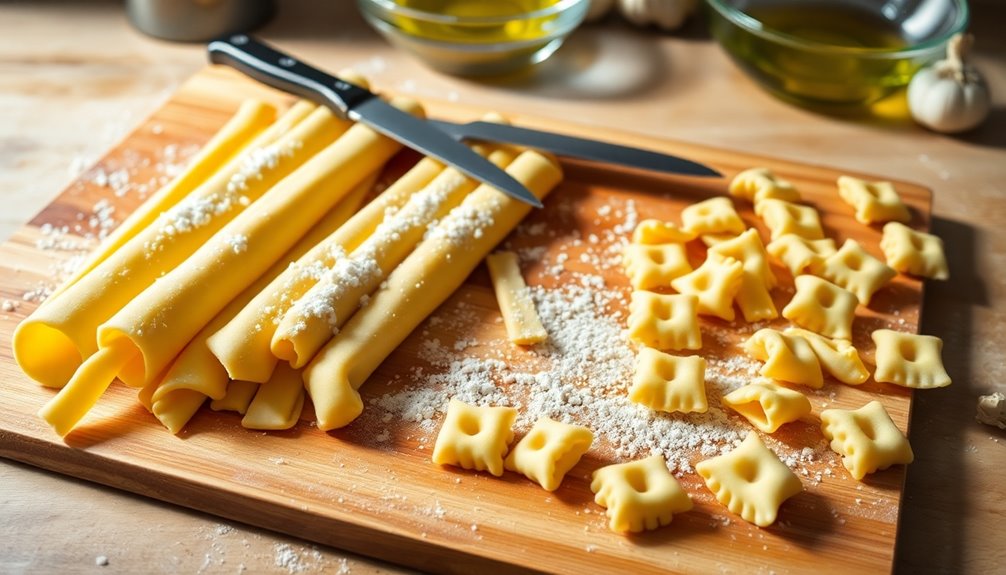
Once your cavatelli dough has rested, it's time to roll it into small pieces.
Start by breaking off a piece of dough about the size of an apricot. Roll it into a long, thin rope, roughly ½ inch in diameter.
Next, cut the rope into short lengths, around ¾ to 1 inch, to create individual pieces of dough.
To shape the cavatelli, press your thumb into the center of each piece and roll it down a gnocchi board or fork to create an indentation. This step helps sauce cling to the fresh pasta.
Dust the shaped cavatelli with semolina flour and arrange them in a single layer on parchment paper to prevent sticking before cooking.
Enjoy your homemade pasta!
Step 3. Form Into Cavatelli Shapes
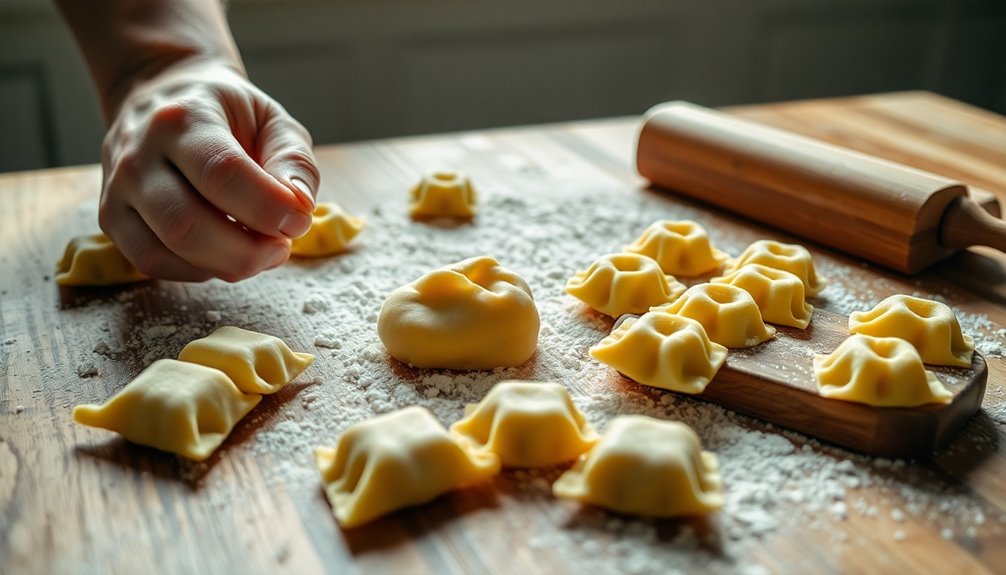
To shape your cavatelli, take a piece of dough about the size of an apricot and roll it into a long rope, roughly ½ inch in diameter.
Cut the rope into short lengths, about ¾ to 1 inch long, to create individual cavatelli pieces.
Using a gnocchi board, fork, or the serrated edge of a butter knife, roll each piece to form an indentation, which helps sauce cling better.
Dust generously with semolina flour to prevent sticking.
Arrange the shaped cavatelli in a single layer on a parchment-lined baking sheet.
Allow them to rest and partially dry for 30 minutes to 1 hour at room temperature before cooking or freezing for later use.
Enjoy your homemade cavatelli!
Step 4. Cook in Boiling Water
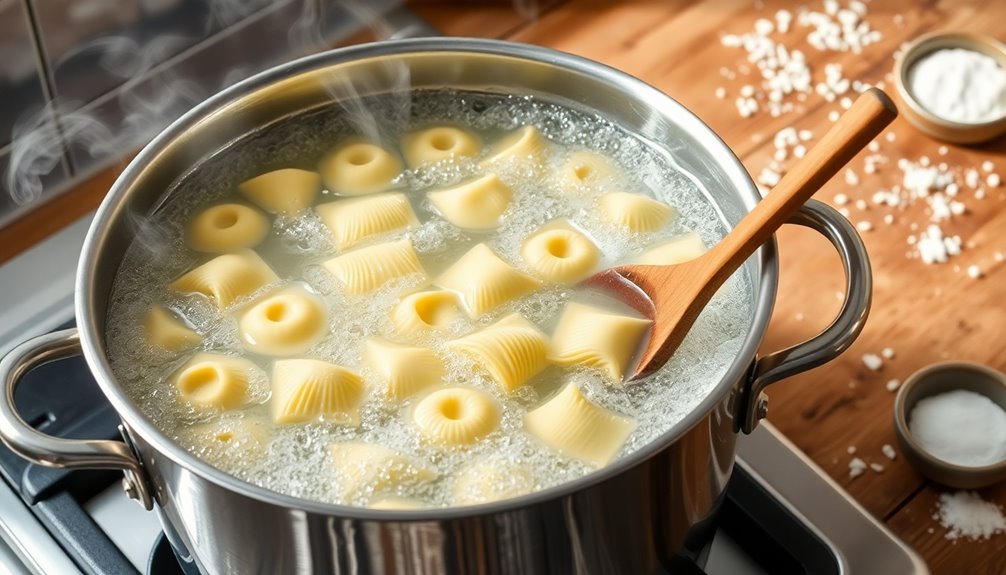
As you prepare to cook your homemade cavatelli, bring a large pot of water to a rolling boil and stir in a heaped tablespoon of salt to enhance their flavor.
Gently add the shaped cavatelli to the boiling water, stirring to prevent them from sticking together. Cook for 8-10 minutes, checking for doneness after 5 minutes.
The cavatelli are ready when they float to the surface and have an al dente texture—be careful not to overcook them, or they'll turn doughy.
Once cooked, drain the cavatelli and get ready to toss them with your favorite sauce. Serve immediately for the best flavor and texture, and consider garnishing with grated cheese for an extra touch.
Enjoy!
Step 5. Drain and Toss With Sauce
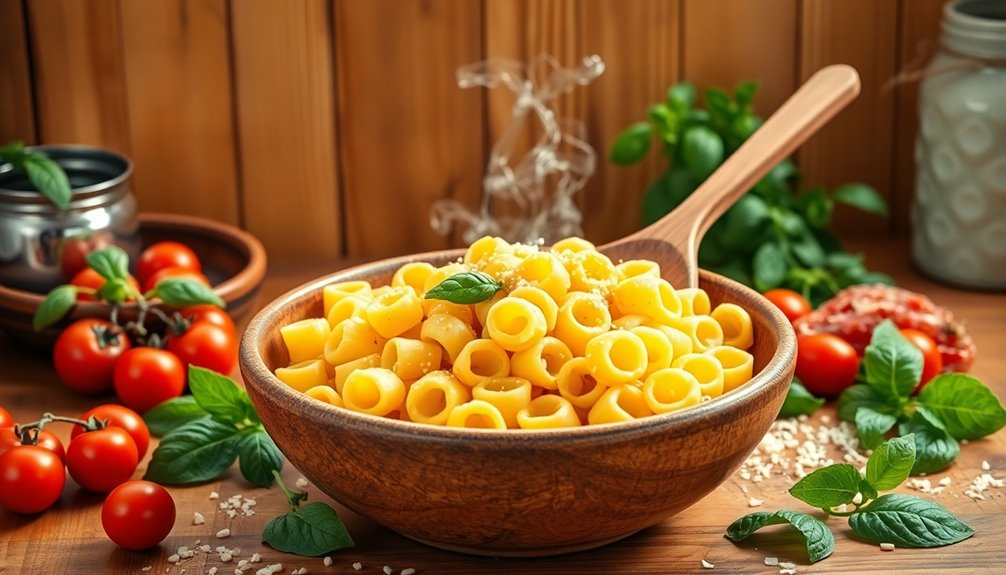
After cooking the cavatelli, it's time to bring everything together with your sauce. Start by bringing a large pot of salted water to a rolling boil.
Cook the cavatelli for about 3 to 6 minutes, stirring gently until they float and reach al dente. Before draining, reserve about 1/4 cup of the pasta cooking water to adjust the sauce consistency later.
Once cooked, drain the cavatelli and immediately transfer them into your warmed sauce. Toss gently to coat the pasta evenly, ensuring each piece is enveloped in flavor.
Be sure to consider automating contributions to your kitchen routine for a more efficient cooking experience. Serve immediately for the best texture and taste, and consider garnishing with grated cheese or fresh herbs for an extra touch. Enjoy your delicious homemade cavatelli!
Final Thoughts
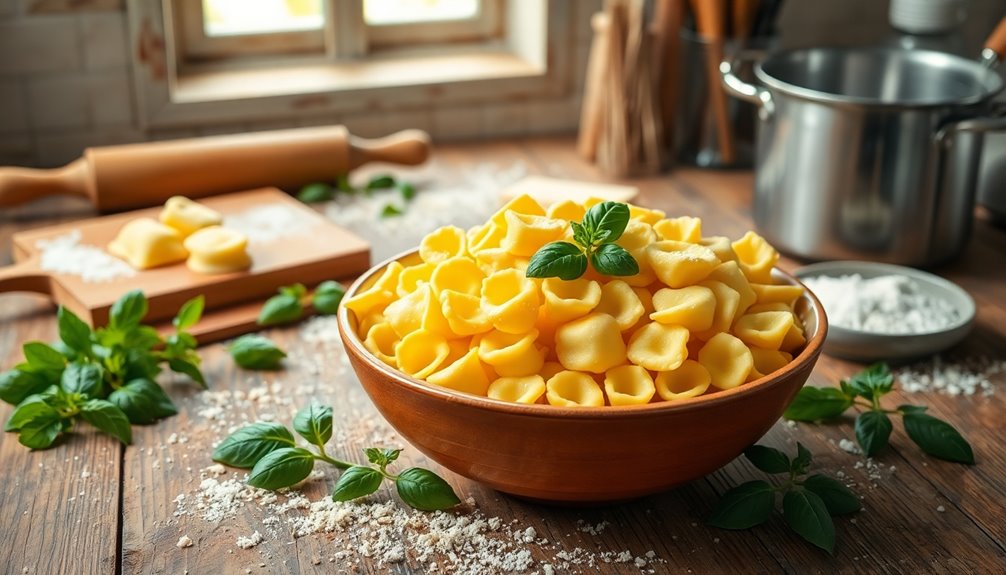
While making homemade cavatelli might seem intimidating at first, it's a rewarding process that allows you to connect with traditional Italian cooking.
Using just semolina flour and water, you create a pasta with a unique texture that captures sauces beautifully. Kneading the dough and letting it rest is essential for shaping the pasta easily by hand.
Once you've shaped the uncooked cavatelli, you can store them in the refrigerator for up to four days, making meal preparation a breeze.
When you're ready to eat, simply boil them in salted water for about 8-10 minutes, then serve immediately with your favorite sauces like ragu or pesto.
Freshly made cavatelli elevates any meal with its delightful texture and taste!
Frequently Asked Questions
What Is the Best Flour for Cavatelli?
When choosing the best flour for cavatelli, you'll want to stick with durum wheat semolina flour. Its high protein content gives your pasta that firm texture you're aiming for.
If you can find double-milled semolina, grab it; it creates a smoother dough. You can also mix it with other flours like 00 or bread flour for added flavor and texture.
Just steer clear of coarse semolina, as it can ruin your dish!
What Do Italians Call Cavatelli?
You won't believe how many names Italians have for cavatelli! While "cavatelli" is the most common, in some regions, they affectionately call it "cavatello" for singular or even "cavatieddi" and "cavatelle."
Each name reflects the local flavor and tradition, making it feel like a secret code among pasta lovers.
What's the Difference Between Gnocchi and Cavatelli?
When you compare gnocchi and cavatelli, you'll notice some key differences.
Gnocchi's made primarily from potatoes, giving it a soft, pillowy texture, while cavatelli uses semolina flour, resulting in a denser, chewier bite.
Cavatelli's shaped by rolling and pressing, creating grooves for sauce, whereas gnocchi often features ridges made with a fork or board.
They're both delicious, but their textures and preparation methods set them apart in the world of pasta.
Is Cavatelli Hard to Make?
Is cavatelli hard to make? Well, if you think crafting delicate pasta shapes is akin to solving a Rubik's Cube blindfolded, you're in for a surprise!
It's actually pretty straightforward. You only need a few ingredients and some basic kitchen tools. With a little kneading and shaping, you'll be a pasta pro in no time.
Plus, it cooks up quick, so you won't be waiting long to enjoy your culinary masterpiece!
